[高中英语跨文化教学探索]跨文化交流英语作文300
- 格式:doc
- 大小:17.66 KB
- 文档页数:7

《跨文化交流的经历》高中生英语作文Title: An Experience of Intercultural CommunicationDuring my high school years, I had the opportunity to participate in a study abroad program, which allowed me to experience intercultural communication firsthand.It was a life-changing experience that broadened my horizons and taught me valuable lessons about tolerance and understanding.The program took place in Japan, a country culturally different from my own.I was excited yet nervous about living in a foreign country, not knowing what to expect.The first challenge I faced was the language barrier.Although I had taken Japanese classes, I found it difficult to communicate with native speakers.However, I quickly realized that body language and a willingness to learn could bridge the gap.One of the most memorable moments I had was when I visited a local temple with a group of Japanese students.Despite the language barrier, we managed to engage in meaningful conversations through gestures and simple words.We shared our cultural experiences, such as traditional tea ceremonies and sumo wrestling, which fascinated me.I also had the chance to teach them about my own culture, which made me proud and more aware of my heritage.Another significant experience was celebrating Japanese festivals with my host family.I remember attending the盂兰盆会(Obon Festival),a traditional Buddhist festival honoring ancestors.Although I did not understand all the rituals, I was touched by the warmth and unity of the family gathering.It taught me the importance of family and cultural traditions.Throughout my stay, I encountered various cultural norms and etiquette that were different from mine.For example, bowing as a form of greeting, removing shoes before entering someone's home, and eating with chopsticks.Initially, I felt awkward and made many mistakes, but gradually, I adapted and learned to appreciate these unique cultural practices.My time abroad also allowed me to reflect on my own cultural identity.Being immersed in a different culture made me realize the value of my own heritage and the importance of preserving it.I became more proud of my nationality and more open-minded towards other cultures.In conclusion, my experience of intercultural communication was invaluable.It not only enhanced my language skills but also broadened my perspective on the world.I learned to appreciate and respect different cultures, and I developed empathy towards people from diverse backgrounds.This experience has shaped me into a more tolerant and understanding individual, ready to embrace the challenges and opportunities of a globalized world.。

跨文化沟通与交流,语言和文化英语作文全文共3篇示例,供读者参考篇1Cross-Cultural Communication and Exchange: Language and CultureIntroductionIn today's globalized world, communication with people from different cultural backgrounds has become increasingly important. As the world becomes more interconnected, the ability to effectively communicate across cultures is essential for building relationships, resolving conflicts, and fostering understanding. One of the key aspects of cross-cultural communication is the role of language and culture in shaping how people interact with one another.Language as a Tool for CommunicationLanguage is a fundamental aspect of culture and plays a crucial role in communication. Language not only serves as a means of expressing thoughts and ideas but also reflects the values, beliefs, and traditions of a particular culture. When individuals from different cultures come together, they oftenface challenges in understanding one another due to differences in language. These differences may manifest in various forms, such as differences in vocabulary, grammar, pronunciation, and even nonverbal communication cues.For example, in some cultures, direct communication is valued, while in others, indirect communication is preferred. This can lead to misunderstandings and misinterpretations if individuals are not aware of cultural differences in communication styles. Additionally, the use of idioms, slang, and cultural references can further complicate communication between people from different cultural backgrounds.Cultural Differences and Communication StylesCultural differences play a significant role in shaping communication styles. For example, in collectivist cultures, such as those in East Asia, communication is often morecontext-dependent and focused on harmony and maintaining relationships. In contrast, individualistic cultures, like those in North America, tend to prioritize individual needs and direct communication styles.These cultural differences can impact how individuals perceive and interpret verbal and nonverbal cues during communication. For instance, gestures, facial expressions, andbody language may carry different meanings across cultures. In some cultures, maintaining eye contact is a sign of respect and attentiveness, while in others, it may be considered rude or confrontational.Strategies for Effective Cross-Cultural CommunicationTo overcome the challenges of cross-cultural communication, individuals must develop strategies to enhance their understanding of different cultural norms and communication styles. Some strategies include:1. Cultural Sensitivity: Being aware of and respecting cultural differences is essential for effective communication. By acknowledging and valuing cultural diversity, individuals can promote mutual understanding and respect in their interactions with people from different backgrounds.2. Active Listening: Listening attentively and empathetically can help individuals better understand the perspectives and intentions of others. Active listening involves paying attention to both verbal and nonverbal cues, as well as asking clarifying questions to ensure clear communication.3. Adaptability: Flexibility and adaptability are crucial for navigating cultural differences in communication. Beingopen-minded and willing to adjust one's communication style to accommodate the preferences of others can foster positive and productive interactions across cultures.4. Cultural Awareness Training: Participating in cultural awareness training programs can help individuals develop the knowledge and skills necessary for effective cross-cultural communication. These programs provide insights into cultural norms, values, and communication styles, enabling individuals to navigate cultural differences more effectively.ConclusionIn conclusion, cross-cultural communication and exchange play a vital role in today's interconnected world. Language and culture are integral components of communication that shape how individuals interact with one another. By recognizing and respecting cultural differences, employing active listening, adaptability, and cultural awareness training, individuals can enhance their ability to communicate effectively across cultures. Ultimately, fostering understanding and building relationships across cultural boundaries is essential for promoting harmony, cooperation, and mutual respect in our diverse and interconnected global community.篇2Cross-cultural communication and exchange play a crucial role in today's globalized world. With the advancements in technology and the ease of travel, people from different cultural backgrounds are interacting and working together more than ever before. However, despite the benefits of this increased connectivity, it also brings challenges in terms of language and cultural differences.Language is an essential tool for communication, and its importance cannot be overstated when it comes to cross-cultural communication. People from different cultures may speak different languages, which can lead to misunderstandings and miscommunication. For example, a simple phrase or gesture in one culture may have a completely different meaning in another culture. Therefore, it is important for individuals engaging in cross-cultural communication to be aware of these language differences and make an effort to learn and understand the language of the other culture.Cultural differences also play a significant role incross-cultural communication. Every culture has its own set of values, beliefs, customs, and traditions, which can shape the way people communicate and interact with each other. For example,in some cultures, being direct and assertive in communication is considered rude, while in others, it is seen as a sign of honesty and openness. Understanding and respecting these cultural differences is essential for effective cross-cultural communication.One key aspect of cross-cultural communication is the ability to be sensitive and empathetic towards others' cultural values and norms. By showing respect for other cultures and being open-minded, individuals can build trust and establish meaningful relationships with people from different cultural backgrounds. This can lead to more effective communication and collaboration, ultimately benefiting both individuals and organizations.In addition, technology has played a significant role in facilitating cross-cultural communication. Platforms such as social media, video conferencing, and instant messaging have made it easier for people from different cultures to communicate and collaborate in real-time. These tools have made it possible for individuals and organizations to overcome language barriers and connect with people from all over the world.In conclusion, cross-cultural communication and exchange are essential in today's globalized world. By understanding andrespecting language and cultural differences, individuals can build meaningful relationships and collaborate effectively with people from different cultural backgrounds. With the advancements in technology, it is now easier than ever to connect with people from around the world and engage in cross-cultural communication. By embracing diversity and cultural differences, individuals can create a more inclusive and interconnected global community.篇3Cross-cultural communication and exchange can be challenging yet extremely rewarding. In today's globalized world, it is becoming increasingly important to understand and appreciate different languages and cultures in order to effectively communicate with people from diverse backgrounds. Language is a key factor in cross-cultural communication, as it not only enables us to convey ideas and information, but also shapes the way we perceive the world around us.Language is not just a tool for communication, but also a reflection of culture. Each language carries with it a unique set of values, beliefs, and traditions that are embedded in its vocabulary, grammar, and expressions. Therefore, when we learn a new language, we are not only acquiring a new means ofcommunication, but also gaining insight into the culture and mentality of its speakers.In cross-cultural communication, understanding and respecting cultural differences is crucial. Cultural norms, customs, and social hierarchies can greatly influence how people communicate and interact with one another. For example, in some cultures, direct communication and assertiveness are valued, while in others, indirect communication and harmony are prioritized. By being aware of these differences and adapting our communication style accordingly, we can avoid misunderstandings and build positive relationships with people from different cultures.Moreover, cross-cultural communication requires empathy, openness, and a willingness to learn from others. It is important to approach interactions with an open mind and a genuine curiosity about other cultures. By showing respect for cultural differences and valuing diversity, we can foster mutual understanding and create a more inclusive and harmonious global community.In addition to language and culture, non-verbal communication plays a significant role in cross-cultural interactions. Body language, gestures, facial expressions, and eyecontact can convey meaning and emotions that transcend linguistic barriers. Paying attention to these non-verbal cues can enhance our understanding of others and help us establish rapport and trust in cross-cultural communication.In conclusion, cross-cultural communication and exchange offer a wealth of opportunities for personal growth, learning, and connection with others. By embracing linguistic diversity, respecting cultural differences, and being open to new perspectives, we can navigate the challenges of communication across cultures and build bridges of understanding and cooperation in an increasingly interconnected world. Let us celebrate the richness and beauty of our diverse languages and cultures, and strive to communicate with compassion, empathy, and respect for all.。
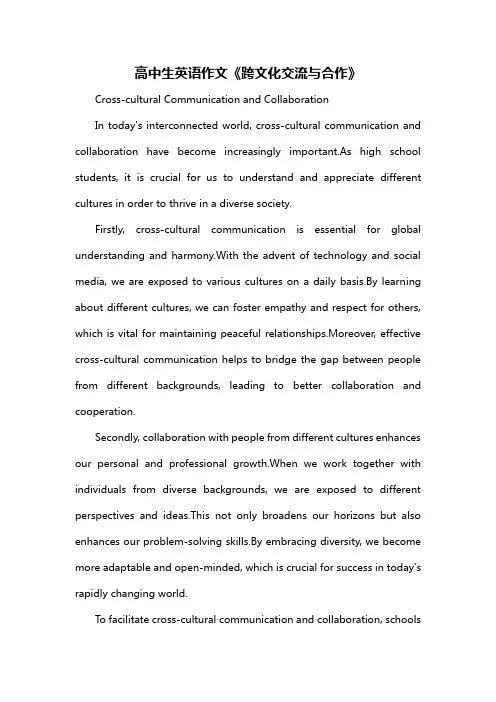
高中生英语作文《跨文化交流与合作》Cross-cultural Communication and CollaborationIn today's interconnected world, cross-cultural communication and collaboration have become increasingly important.As high school students, it is crucial for us to understand and appreciate different cultures in order to thrive in a diverse society.Firstly, cross-cultural communication is essential for global understanding and harmony.With the advent of technology and social media, we are exposed to various cultures on a daily basis.By learning about different cultures, we can foster empathy and respect for others, which is vital for maintaining peaceful relationships.Moreover, effective cross-cultural communication helps to bridge the gap between people from different backgrounds, leading to better collaboration and cooperation.Secondly, collaboration with people from different cultures enhances our personal and professional growth.When we work together with individuals from diverse backgrounds, we are exposed to different perspectives and ideas.This not only broadens our horizons but also enhances our problem-solving skills.By embracing diversity, we become more adaptable and open-minded, which is crucial for success in today's rapidly changing world.To facilitate cross-cultural communication and collaboration, schoolscan play a significant role.Firstly, schools can offer language courses that teach students about different cultures.By learning a new language, students can gain a deeper understanding of the cultural nuances and communicate effectively with people from different backgrounds.Additionally, schools can organize cultural exchange programs, where students can interact with peers from different countries.This not only promotes cross-cultural understanding but also fosters lifelong friendships.Furthermore, extracurricular activities such as debate clubs, Model United Nations, and international youth conferences provide platforms for students to engage in cross-cultural discussions and collaborations.These activities encourage critical thinking, public speaking, and teamwork skills, which are essential for success in a globalized world.In conclusion, cross-cultural communication and collaboration are vital skills for high school students in today's diverse and interconnected world.By embracing diversity, we can foster global understanding, enhance personal and professional growth, and contribute to a more harmonious society.Therefore, it is crucial for schools to provide opportunities for students to learn about different cultures and engage in cross-cultural interactions.。
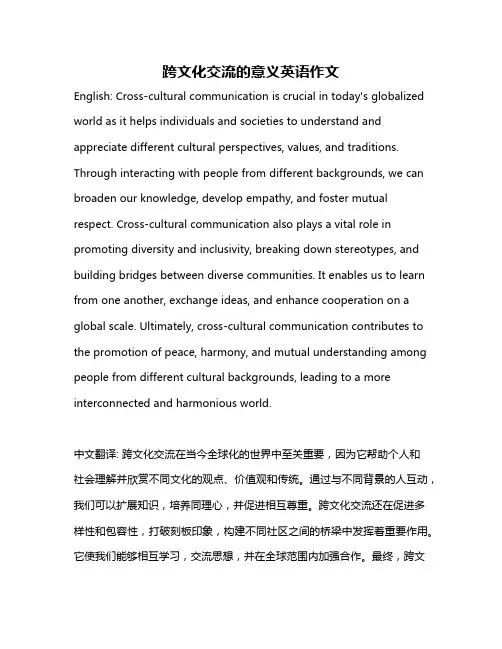
跨文化交流的意义英语作文English: Cross-cultural communication is crucial in today's globalized world as it helps individuals and societies to understand and appreciate different cultural perspectives, values, and traditions. Through interacting with people from different backgrounds, we can broaden our knowledge, develop empathy, and foster mutual respect. Cross-cultural communication also plays a vital role in promoting diversity and inclusivity, breaking down stereotypes, and building bridges between diverse communities. It enables us to learn from one another, exchange ideas, and enhance cooperation on a global scale. Ultimately, cross-cultural communication contributes to the promotion of peace, harmony, and mutual understanding among people from different cultural backgrounds, leading to a more interconnected and harmonious world.中文翻译: 跨文化交流在当今全球化的世界中至关重要,因为它帮助个人和社会理解并欣赏不同文化的观点、价值观和传统。
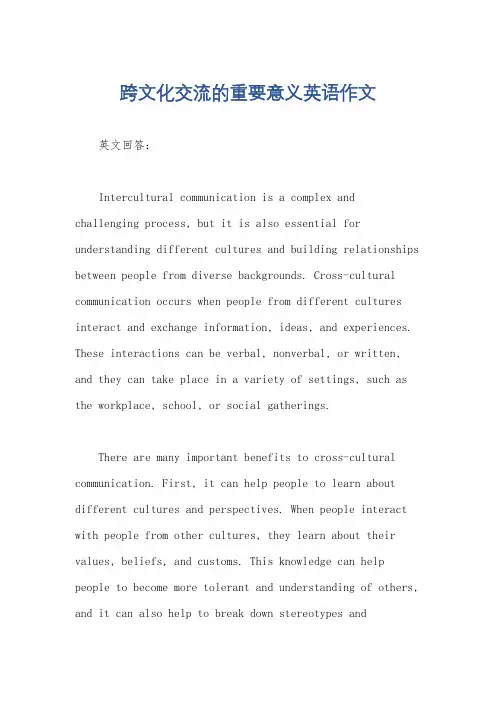
跨文化交流的重要意义英语作文英文回答:Intercultural communication is a complex and challenging process, but it is also essential for understanding different cultures and building relationships between people from diverse backgrounds. Cross-cultural communication occurs when people from different cultures interact and exchange information, ideas, and experiences. These interactions can be verbal, nonverbal, or written, and they can take place in a variety of settings, such as the workplace, school, or social gatherings.There are many important benefits to cross-cultural communication. First, it can help people to learn about different cultures and perspectives. When people interact with people from other cultures, they learn about their values, beliefs, and customs. This knowledge can help people to become more tolerant and understanding of others, and it can also help to break down stereotypes andprejudices.Second, cross-cultural communication can help people to develop new skills and knowledge. When people interact with people from other cultures, they learn about new ways of thinking and doing things. This knowledge can be valuablein both personal and professional life. For example, people who work in international business need to have strong cross-cultural communication skills in order to be successful.Third, cross-cultural communication can help people to build relationships with people from other cultures. When people interact with people from other cultures, they build trust and understanding. These relationships can be valuable for both personal and professional reasons. For example, people who have friends from other cultures can learn about new cultures and perspectives, and they can also get help with things like finding a job or getting a visa.Of course, cross-cultural communication can also bechallenging. There are a number of barriers to cross-cultural communication, such as language barriers, cultural differences, and stereotypes. However, these barriers can be overcome with patience, understanding, and a willingness to learn.Here are some tips for effective cross-cultural communication:Be respectful of other cultures.Be aware of your own cultural biases.Listen actively to what others have to say.Be patient and understanding.Be willing to learn new things.With a little effort, anyone can learn to communicate effectively with people from other cultures. Cross-cultural communication is an essential skill for anyone who wants tolive and work in a globalized world.中文回答:跨文化交流是一个复杂且具有挑战性的过程,但对于理解不同文化并在具有不同背景的人们之间建立关系至关重要。
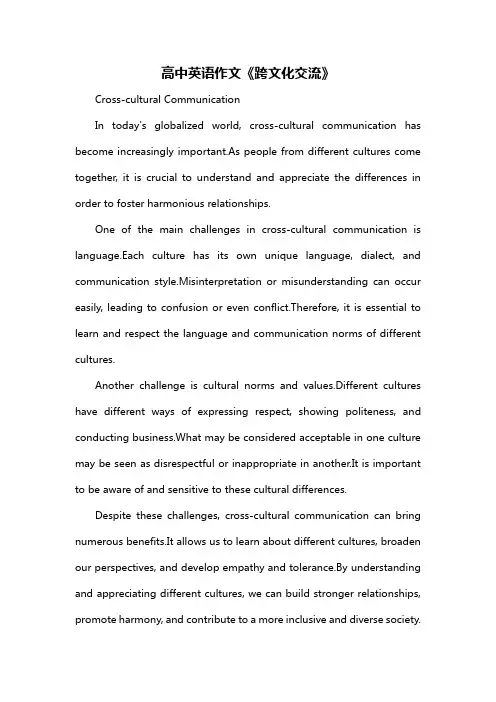
高中英语作文《跨文化交流》Cross-cultural CommunicationIn today's globalized world, cross-cultural communication has become increasingly important.As people from different cultures come together, it is crucial to understand and appreciate the differences in order to foster harmonious relationships.One of the main challenges in cross-cultural communication is language.Each culture has its own unique language, dialect, and communication style.Misinterpretation or misunderstanding can occur easily, leading to confusion or even conflict.Therefore, it is essential to learn and respect the language and communication norms of different cultures.Another challenge is cultural norms and values.Different cultures have different ways of expressing respect, showing politeness, and conducting business.What may be considered acceptable in one culture may be seen as disrespectful or inappropriate in another.It is important to be aware of and sensitive to these cultural differences.Despite these challenges, cross-cultural communication can bring numerous benefits.It allows us to learn about different cultures, broaden our perspectives, and develop empathy and tolerance.By understanding and appreciating different cultures, we can build stronger relationships, promote harmony, and contribute to a more inclusive and diverse society.In conclusion, cross-cultural communication is a vital skill in today's interconnected world.It requires an open mind, a willingness to learn, and respect for cultural differences.By embracing cross-cultural communication, we can foster understanding, build bridges between cultures, and create a more harmonious and tolerant world.。
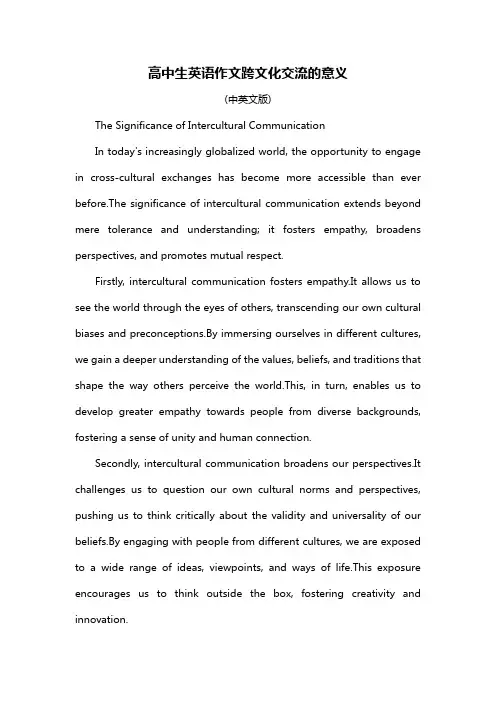
高中生英语作文跨文化交流的意义(中英文版)The Significance of Intercultural CommunicationIn today's increasingly globalized world, the opportunity to engage in cross-cultural exchanges has become more accessible than ever before.The significance of intercultural communication extends beyond mere tolerance and understanding; it fosters empathy, broadens perspectives, and promotes mutual respect.Firstly, intercultural communication fosters empathy.It allows us to see the world through the eyes of others, transcending our own cultural biases and preconceptions.By immersing ourselves in different cultures, we gain a deeper understanding of the values, beliefs, and traditions that shape the way others perceive the world.This, in turn, enables us to develop greater empathy towards people from diverse backgrounds, fostering a sense of unity and human connection.Secondly, intercultural communication broadens our perspectives.It challenges us to question our own cultural norms and perspectives, pushing us to think critically about the validity and universality of our beliefs.By engaging with people from different cultures, we are exposed to a wide range of ideas, viewpoints, and ways of life.This exposure encourages us to think outside the box, fostering creativity and innovation.Lastly, intercultural communication promotes mutual respect.It helps us recognize and appreciate the diversity of cultures, understanding that no one culture is superior to another.By engaging in meaningful dialogue and exchange with people from different cultures, we learn to respect and value their unique perspectives and traditions.This respect is essential in creating a harmonious and inclusive society, where people from all backgrounds feel accepted and valued.In conclusion, the significance of intercultural communication cannot be overstated.It fosters empathy, broadens our perspectives, and promotes mutual respect.As high school students, it is crucial for us to embrace intercultural communication, as it not only prepares us for an increasingly interconnected world but also helps us become more open-minded, empathetic, and respectful individuals.。
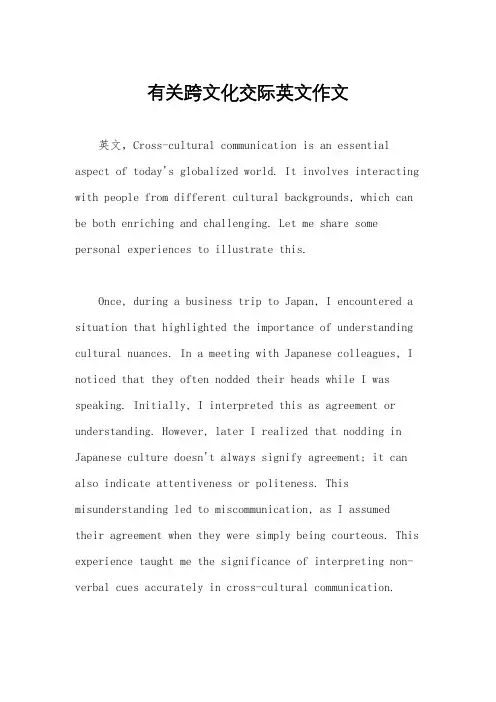
有关跨文化交际英文作文英文,Cross-cultural communication is an essential aspect of today's globalized world. It involves interacting with people from different cultural backgrounds, which can be both enriching and challenging. Let me share some personal experiences to illustrate this.Once, during a business trip to Japan, I encountered a situation that highlighted the importance of understanding cultural nuances. In a meeting with Japanese colleagues, I noticed that they often nodded their heads while I was speaking. Initially, I interpreted this as agreement or understanding. However, later I realized that nodding in Japanese culture doesn't always signify agreement; it can also indicate attentiveness or politeness. This misunderstanding led to miscommunication, as I assumedtheir agreement when they were simply being courteous. This experience taught me the significance of interpreting non-verbal cues accurately in cross-cultural communication.Another instance occurred during a cultural exchange program in Brazil. While conversing with locals, I noticed they often stood close to me and used expressive gestures. At first, I felt uncomfortable with the proximity, as personal space boundaries vary across cultures. However, I gradually adapted and even found it refreshing to engage in such close, animated conversations. This experience taught me the importance of respecting and adapting to different cultural norms, even if they initially seem unfamiliar.中文,跨文化交际在今天全球化的世界中至关重要。
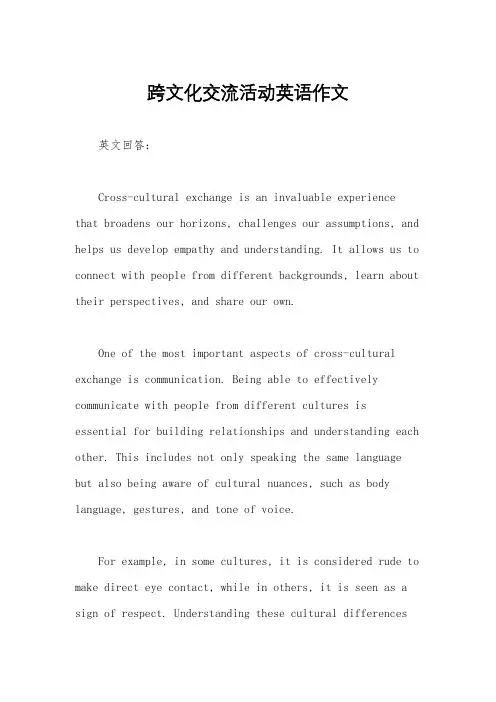
跨文化交流活动英语作文英文回答:Cross-cultural exchange is an invaluable experiencethat broadens our horizons, challenges our assumptions, and helps us develop empathy and understanding. It allows us to connect with people from different backgrounds, learn about their perspectives, and share our own.One of the most important aspects of cross-cultural exchange is communication. Being able to effectively communicate with people from different cultures isessential for building relationships and understanding each other. This includes not only speaking the same language but also being aware of cultural nuances, such as body language, gestures, and tone of voice.For example, in some cultures, it is considered rude to make direct eye contact, while in others, it is seen as a sign of respect. Understanding these cultural differencescan help us avoid misunderstandings and communicate more effectively.Another important aspect of cross-cultural exchange is respect. It is important to be respectful of other cultures, even if they are different from our own. This means being open-minded, accepting of differences, and avoiding making judgments.For example, in some cultures, it is customary to remove one's shoes before entering someone's home, while in others, it is not. Being aware of these cultural customsand respecting them shows that we care about the other person's culture and that we are interested in learningmore about it.Cross-cultural exchange can also be a challenging experience. It can be difficult to adjust to new customs, beliefs, and values. However, it is important to remember that these challenges are also opportunities for growth and learning. By embracing the challenges of cross-cultural exchange, we can become more adaptable, resilient, andopen-minded.For example, when I first moved to a new country, I found it difficult to adjust to the different food. The flavors and textures were unfamiliar to me, and I oftenfelt homesick for the foods I was used to eating. However, over time, I learned to appreciate the new cuisine and even grew to love some of the dishes that I initially found strange.Cross-cultural exchange is an enriching and rewarding experience that can change our lives in profound ways. It can help us become more tolerant, understanding, and open-minded. It can also help us develop new skills, learn about new cultures, and make lifelong friends.中文回答:跨文化交流是一种无价的体验,它开阔了我们的视野,挑战了我们的假设,并帮助我们培养了同理心和理解力。

跨文化接触英文作文英文:Cross-cultural contact is an important aspect of modern society. As someone who has experienced it firsthand, I can say that it can be both exciting and challenging. On the one hand, it's fascinating to learn about other cultures and customs. On the other hand, there can be misunderstandings and miscommunications that can make things difficult.For example, when I first moved to China, I was surprised by how different the culture was from what I was used to. I had to learn how to navigate the languagebarrier and cultural norms. I also had to learn to be patient and open-minded when things didn't go as planned. But through it all, I gained a deeper understanding and appreciation for Chinese culture.中文:跨文化接触是现代社会的一个重要方面。
作为亲身经历过的人,我可以说,它既令人兴奋又具有挑战性。
一方面,了解其他文化和习俗是很有趣的。
另一方面,可能会有误解和沟通不畅的情况,这可能会使事情变得困难。
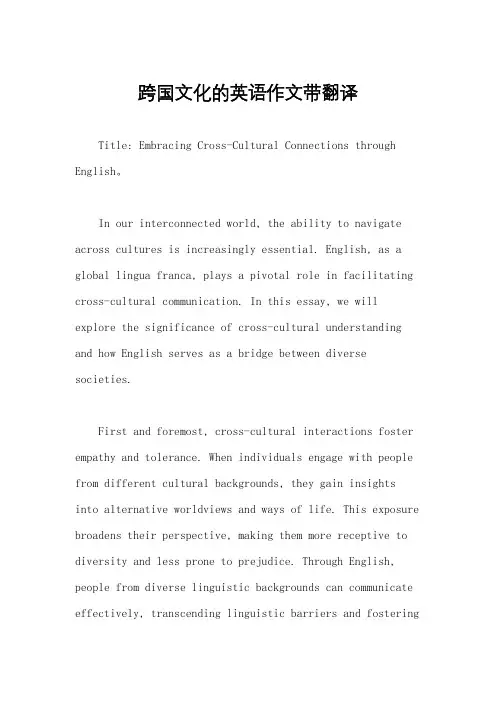
跨国文化的英语作文带翻译Title: Embracing Cross-Cultural Connections through English。
In our interconnected world, the ability to navigate across cultures is increasingly essential. English, as a global lingua franca, plays a pivotal role in facilitating cross-cultural communication. In this essay, we will explore the significance of cross-cultural understanding and how English serves as a bridge between diverse societies.First and foremost, cross-cultural interactions foster empathy and tolerance. When individuals engage with people from different cultural backgrounds, they gain insightsinto alternative worldviews and ways of life. This exposure broadens their perspective, making them more receptive to diversity and less prone to prejudice. Through English, people from diverse linguistic backgrounds can communicate effectively, transcending linguistic barriers and fosteringmutual understanding.Moreover, English proficiency opens doors to a wealth of opportunities in the globalized job market. In multinational corporations, proficiency in English is often a prerequisite for international assignments and collaborations. Employees who are adept in English can seamlessly navigate multicultural work environments, contributing to innovation and productivity. Additionally, English fluency enhances one's employability, as it enables individuals to access a vast array of resources, ranging from online courses to academic literature, furtheringtheir professional development.Furthermore, English serves as a medium for cultural exchange and mutual enrichment. Through literature, film, music, and other forms of artistic expression, individuals can immerse themselves in diverse cultures and gain a deeper appreciation for humanity's rich tapestry. For instance, reading novels by authors from different countries allows readers to vicariously experience life through varied cultural lenses. Similarly, watching foreignfilms with English subtitles enables audiences to explore unfamiliar narratives and aesthetic traditions.It is important to recognize that embracing cross-cultural connections through English requires humility and open-mindedness. Language is deeply intertwined with culture, and nuances in communication can easily be misunderstood without cultural context. Therefore, learners of English must approach language acquisition with a genuine curiosity about different cultures, seeking to learn not only grammar and vocabulary but also cultural norms and values.In conclusion, English serves as a powerful tool for bridging cultural divides and fostering global citizenship. By promoting empathy, facilitating professional opportunities, and facilitating cultural exchange, English empowers individuals to engage with the world in meaningful ways. As we continue to navigate an increasingly interconnected world, let us embrace the richness of diversity and harness the potential of English to build bridges across cultures.中文翻译:标题,通过英语拥抱跨文化交流。
Cross-Cultural Communication Competence: The Key to Successful Global InteractionIn an increasingly interconnected world, the importance of cross-cultural communication competence has become paramount. The ability to effectively communicate across cultural barriers is crucial for personal and professional success. This essay explores the essence of cross-cultural communication competence, its significance, and strategies to develop this crucial skill.Cross-cultural communication competence is the ability to communicate effectively and appropriately in diverse cultural contexts. It involves understanding and respecting cultural differences, adapting communication styles to fit the cultural norms of the other party, and managingconflict and misunderstandings that may arise due to cultural differences. This competence is essential intoday's globalized world, where people from diverse backgrounds interact frequently in business, education, and social settings.The significance of cross-cultural communication competence lies in its ability to bridge cultural dividesand foster mutual understanding. In the business world, for instance, cross-cultural communication skills are crucial for successful international collaborations and negotiations. In education, they are essential for creating an inclusive learning environment where students from different cultures can learn together effectively. Insocial settings, they promote cultural exchange and understanding, leading to greater tolerance and respect among people.Developing cross-cultural communication competence requires a conscious effort and a continuous process of learning and adaptation. Here are some strategies that can help individuals enhance their cross-cultural communication skills:1. Cultural awareness: Gaining knowledge aboutdifferent cultures, their values, beliefs, and communication styles is crucial. This can be achieved through reading books, articles, and websites that provide insights into different cultures. Participating in cultural exchange programs and interacting with people from diverse backgrounds can also be beneficial.2. Language proficiency: Language is a key component of cross-cultural communication. Mastering the language of the other culture, including its vocabulary, grammar, and idiomatic expressions, can help individuals communicate more effectively. Additionally, learning to speak with a cultural accent and intonation can further enhance communication.3. Adaptability: Being flexible and willing to adapt one's communication style to fit the cultural norms of the other party is essential. This involves understanding and respecting the communication preferences and taboos of the other culture and adapting one's behavior accordingly.4. Active listening: Active listening is a crucialskill in cross-cultural communication. It involves paying attention to what the other person is saying, understanding their perspective, and responding appropriately. Active listening helps individuals build trust and rapport with their interlocutors, leading to more effective communication.5. Conflict management: Cultural differences can sometimes lead to conflicts and misunderstandings. It isimportant to have strategies to manage these conflicts constructively. This involves remaining calm and respectful, seeking clarification when needed, and using appropriate conflict resolution techniques.In conclusion, cross-cultural communication competenceis a crucial skill for success in today's globalized world. By developing a deep understanding of different cultures, mastering the language, adapting communication styles, actively listening, and managing conflicts constructively, individuals can effectively communicate across cultural barriers and foster mutual understanding and respect. This, in turn, can lead to enhanced personal and professional success in the global arena.**跨文化交际能力的重要性:全球互动成功的关键** 在日益相互关联的世界中,跨文化交际能力的重要性变得至关重要。
跨文化交流作文英文英文:Cross-cultural communication is a fascinating realm, brimming with opportunities and challenges alike. Having experienced numerous instances of cultural exchange, I can attest to its enriching nature. Let me delve into some of my encounters and insights.One memorable cross-cultural exchange occurred during my trip to Japan. While conversing with locals, I observed their meticulous attention to etiquette and politeness. For instance, the concept of "saving face" was evident in their interactions, where individuals avoided causing embarrassment or discomfort to others. I vividly remember a scenario where I unintentionally made a gesture that could have been perceived as rude. Instead of openly expressing offense, the Japanese individual gracefully redirected the conversation, preserving harmony.Another instance that stands out is my time spent in Spain. The Spanish culture exudes warmth and vibrancy, reflected in their expressive communication style. During a traditional Spanish meal with a host family, I learned the importance of "sobremesa" – the leisurely conversationthat takes place after a meal. This period of relaxed discussion allowed us to delve into diverse topics, ranging from culture and politics to personal anecdotes, fostering a deeper connection.In contrast, cross-cultural misunderstandings can arise if one is unaware of cultural nuances. For instance, a casual thumbs-up gesture, commonly used in Western cultures to express approval, might be perceived differently in the Middle East, where it can connote vulgarity. Such instances highlight the importance of cultural sensitivity and adaptability in communication.Reflecting on these experiences, I've realized the significance of embracing diversity and actively seeking to understand different cultural perspectives. It's not merely about language proficiency but also about empathy andopenness to learning. By immersing oneself in another culture, whether through travel, literature, or interpersonal interactions, one gains invaluable insights into the complexities of human communication.中文:跨文化交流是一个充满机遇和挑战的迷人领域。
跨文化交流的体验高中英语作文Title: The Experience of Cross-cultural CommunicationDuring my high school years, I had the privilege of participating in a cross-cultural exchange program, which allowed me to interact with students from different countries.This experience not only broadened my horizons but also taught me valuable lessons about tolerance and understanding.The program began with a series of orientation sessions, where we were introduced to the various cultures represented in the group.We learned about their customs, traditions, and languages.It was fascinating to discover the diversity among us, and I became eager to immerse myself in these new cultures.One of the most memorable parts of the exchange was the homestay experience.I was paired with a host family from Japan, and I spent a week living with them.Although there were language barriers and cultural differences, we managed to communicate effectively through gestures and laughter.They introduced me to traditional Japanese cuisine, and I shared some of my own cultural practices with them.This exchange created a deep bond between us, and I still keep in touch with them today.Another highlight of the program was the opportunity to attend school with my exchange counterparts.I was surprised to see that despite the differences in education systems, we shared many common interestsand challenges.We discussed various topics in class, and I learned a lot from their perspectives.This experience showed me that education is a universal tool that can bridge cultural gaps.One challenge I faced during the exchange was the language barrier.I quickly realized that speaking English was not enough; I needed to understand and respect the cultural context behind the language.I learned to be patient and open-minded when communicating with people from different backgrounds, and this has served me well in my future interactions.Overall, the experience of cross-cultural communication was invaluable.It allowed me to gain a deeper appreciation for diversity and to develop empathy towards people from different cultures.I learned that embracing differences can lead to meaningful connections and personal growth.As I continue to navigate through life, I am committed to carrying these lessons with me and fostering a culture of understanding and tolerance.。
跨文化交流英语作文优秀范文英语作文是用英语的语言来写的文章,以跨文化交流为题的英语作文如何写是人们好奇的。
以下是店铺分享的跨文化交流英语作文,希望对你有所帮助!跨文化交流英语作文篇一The increase in international business and in foreign investment has created a need for executives with knowledge of foreign languages and skills in cross-cultural communication. Americans, however, have not been well trained in either area and, consequently, have not enjoyed the same level of success in negotiation in an international arena as have their foreign counterparts.Negotiating is the process of communicating back and forth for the purpose of reaching an agreement. It involves persuasion and compromise, but in order to participate in either one, the negotiators must understand the ways in which people are persuaded and how compromise is reached within the culture of the negotiation.In many international business negotiations abroad, Americans are perceived as wealthy and impersonal. It often appears to the foreign negotiator that the American represents a large multi-million-dollar corporation that can afford to pay the price without bargaining further. The American negotiator's role becomes that of an impersonal purveyor of information and cash.In studies of American negotiators abroad, several traits have been identified that may serve to confirm this stereotypical perception, while undermining the negotiator's position. Two traits in particular that cause cross-cultural misunderstanding are directness and impatience on the part of the American negotiator.Furthermore, American negotiators often insist on realizing short-term goals. Foreign negotiators, on the other hand, may value the relationship established between negotiators and may be willing to invest time in it for long-term benefits. In order to solidify the relationship, they may opt for indirect interactions without regard for the time involved in getting to know the other negotiator.带翻译:国际贸易和海外投资的增加产生了需要管理人员的外语知识和跨文化交际的技能。
跨文化交流的英语作文在学习、工作乃至生活中,大家一定都接触过作文吧,作文是一种言语活动,具有高度的综合性和创造性。
那么问题来了,到底应如何写一篇优秀的作文呢?以下是小编整理的跨文化交流的.英语作文,欢迎大家借鉴与参考,希望对大家有所帮助。
跨文化交流的英语作文篇1How to Make a Successful Intercultural Communication?With the development of global cooperation and frequent world-wide activities, people can't help involving in intercultural communications. However, due to the distinction of their cultural background, sense of worth and languages, it's uneasy to make the communication smooth and successful.There're several suggestions on how to make the intercultural communication carry the point. On the one hand, it's quite useful to learn some information on their culture, language and customs in advance, which will help you avoid embarrassment and miscomprehension while contacting others. For example, Japanese businessmen usually will behave more implicitly than Americans in the process of commercial negotiation. Knowing about this, you probably will negotiate with them in a different style. On the other hand, people should respect the customs of the opposing party and get rid of prejudice and stereotype. Of course, if your actions offend other people unwittingly, you'd better say apology and correct your behavior in time.A successful intercultural communication is not only beneficial to improve bilateral relations but also could enhance understanding between nations. So we should work together to make it.跨文化交流的英语作文篇2There is no denying that the cultural exchanges are playing a more and more important role in the modern world.Firstly,let’s have a look at the picture. A foreign lady is XXX a traditional Chinese painting of bamboos. It seems that she is totally indulged in her painting. The picture shows that people from foreign countries are interested in our traditional Chinese culture. They not only appreciate the traditional Chinese paintings, music, costume, etc, but also begin to learn to how to make them. In this way,they hope to gain a better understanding of Chinese culture and thus can know the country better. Since our country became more open,our Chinese government has made great efforts to promote all kinds of exchanges with the outside world. These exchanges range from economics and education to culture. The cultural exchanges play a more and more important part in our life. Many channels are open for the foreigners to learn our traditional art. They can take some courses in some special schools and many professionals can be their teachers.In my opinion, the cultural exchange is good to all of us. It is an efficient way to introduce our Chinese culture to the world. In this way, people in the foreign countries can know more and more about China. Some biased views about our country can be dispelled.跨文化交流的英语作文篇3Communication is the activity of conveying information through the exchange of thought, messages, or information. There are many communicating methods, such as speech, visuals, signals, writing or body languages.It plays an important role in social lives of human beings,which some people consider that it’s the basic of human existence.On the one hand, it’s the communication that spreads information, making us know the news although it’s far from us. By communicating with others, people send and get information that helps us know about our surroundings. We all know that information is extremely important in our lives. On the other hand, communication builds personal relationship, which connects different people together. We live in the same society which makes personal relationship essential in lives. Only with communication can we build and keep good personal relationships with others. In addition, communication can eliminate misunderstandings and promote emotions. When we have misunderstandings with others, timely communicating is the only effective way to solve it.In short, communication is essential to all people that everyone should realize that. Therefore, we should learn how to communicate with other effectively.跨文化交流的英语作文篇4The modern technology has greatly altered the mode ofcommunication among people. With the help of the Internet, people can easily contact each other anytime anywhere. However, the side effect is that many people have become over-dependent on the Internet and neglected face-to-face far as I'm concerned, electronic communication cannot fully replace the direct contact among people. Although it seems to bring everyone together, it actually estranges people and decreases the effectiveness of communication.A typical example is that, traditionally, people working in the same office simply walk to others and talk. Today, however, co-workers tend to send e-mails or instant messages through the Internet even when they are sitting next to each other. As words can never convey the full message, it usually takes much more time and rounds of conversation than face-to-face communication, in which people can discuss more directly with less loss of conclude, the Internet enables more effective communication in some situations, but over-dependence on it actually pulls people apart.跨文化交流的英语作文篇5I have recently done a survey about how students find study partners.Some students find study partners through the Internet. They believe it’s convenient to find partners to study with o nline. Besides, they can get help from study partners whenever necessary. Some students prefer to join clubs to find study partners so that they can share experience face to face. What’s more, they think working out problems together helps learn more easily.As for me, I’d like to get study partners by going to summer camp because I can learn something new while having fun. Also, it’s a good way to learn how to get on well with others.跨文化交流的英语作文篇6Which is better for communication with your friends,writing letter or making a phone call?With the rapid development of technology,a growing number of electrical products appear and gradually gain their popularity.Recently there is a hot debate on the topic that which one is better for communication with your friends,writing letter or making a phone call?In my opinion,phone is a better way to communicate with others.There are some reasons accounting for my view.First of all,it is more convenient for us to call others.Mobile phone is small and light to carry with.Wherever and whenever you are,you can easily get touch with your friends if they are using the phone at the same time.While it takes much time when the letter arrives at your friends’.Once you have something urgent to tell them,it will be delayed.Second,the purpose of technological development is to meet people’s demand of pursing a better and more efficient life.If we all choose to write a letter,nothing will drive science and technology to make the progress.As a result of it,the society will st but not least,phone has more advantages over the amount of information and the consuming time.Even in terms of environmental protection,the paper of writing a letter comes from trees,which is opposite with the concept of friendly environment.All in all,I tend to make a phone call rather than writing a letter when communicating with others.跨文化交流的英语作文篇7it is common in english to ask people about their holidays. in the west many families go away on holiday during the summer months and so it is very usual to ask about this. if the holiday has not yet taken place,then their holiday plans can be talked about. and if it is already over,then where they went,whether they enjoyed it and so on can be discussed. similar questions are asked before festivals and pubic holidays.foreigners living and working in china often have frequent opportunities for travel,either at weekends or during their holiday periods,so questions on this topic can often lead to fruitful discussions. they may be particularly interested to hear comments on which places are worth visiting and why,especially if these places are a little less well known and not clearly described in the tour guides.take vacaticn and long weekends. never let vacation time expire.。
跨文化交流的英语作文Cross-cultural communication is an essential skill in today's globalized world. As the world becomes more interconnected, people from different cultural backgrounds are increasingly coming into contact with one another. This presents both opportunities and challenges. In this essay, I will explore the importance of cross-cultural communication and provide some strategies for effective communication across cultures.First and foremost, cross-cultural communication is important because it helps to promote understanding and mutual respect among people from different cultural backgrounds. When we take the time to learn about and understand the customs, traditions, and values of others, we are better able to relate to them and build meaningful relationships. This can lead to increased cooperation and collaboration, both on a personal and professional level.Additionally, cross-cultural communication is essentialfor businesses and organizations that operate in a global context. In order to be successful in international markets, it is crucial to understand the cultural nuances and differences that exist in different parts of the world. By being aware of these differences and adapting our communication style accordingly, we can avoid misunderstandings and build stronger relationships with clients and partners from diverse cultural backgrounds.In order to effectively communicate across cultures, it is important to be aware of our own cultural biases and assumptions. We all have a tendency to view the world through the lens of our own culture, and this can sometimes lead to misunderstandings when interacting with people from different backgrounds. By acknowledging our own cultural perspective and being open to learning about others, we can bridge the gap and communicate more effectively.Another important aspect of cross-cultural communication is the ability to be flexible and adaptable. Different cultures have different communication styles, and what may be considered polite and respectful in one culturemay be perceived as rude or inappropriate in another. By being open to different ways of communicating and adjusting our own behavior accordingly, we can avoid inadvertently causing offense and build trust with people from diverse cultural backgrounds.In addition to being aware of cultural differences, it is also important to be mindful of language barriers when communicating across cultures. Language is a powerful tool for communication, but it can also be a barrier when people do not share a common language. In these situations, it is important to be patient and understanding, and to seek out alternative means of communication, such as using a translator or interpreter.Finally, it is important to approach cross-cultural communication with an attitude of curiosity and respect. Instead of assuming that our own way of doing things is the best or only way, we should approach interactions with people from different cultures with an open mind and a willingness to learn. By showing genuine interest in others and their cultural background, we can build trust andrapport, and foster positive and meaningful relationships.In conclusion, cross-cultural communication is an essential skill in today's globalized world. By being aware of cultural differences, being flexible and adaptable, and approaching interactions with curiosity and respect, we can bridge the gap and communicate effectively with people from diverse cultural backgrounds. This not only promotes understanding and mutual respect, but also opens up opportunities for collaboration and cooperation on a global scale.。
[高中英语跨文化教学探索]跨文化交流英语作文300
摘要:在以往的英语教学中,英语知识内容诸如词汇、短语、语法等得到了过多的重视,但是却忽略了语言不能脱离文化而单独存在的事实。
最终结果就是学生学了很久的英语,但却没有培养学生用英语语言进行沟通和交流的能力。
关键词:文化意识中学英语课堂教学
交际跨文化交际能力
一、在英语教学中,英语国家文化背景教育的必要性、重要性和紧迫性
在传统的英语教学中,诸如词汇、短语、语法等英语知识内容受到了广泛的关注,而英语作为一个民族的语言文化背景却大大地被忽略了。
学生学了几年英语,对英语母语之间的文化差异以及英语民族的风俗习惯一无所知。
因此,我们经常听到学生说出典型的中国式英语就不足为奇了。
在我就读的大学课堂里曾经发生过一件有趣的事:一次学校请美国的外教George Hank给英语专业大一的学生做“英美文化的交流”讲座,Hank先生站在了主席台的中间准备发言。
我作为服务人员,默默地搬了一把椅子,放在了他的后边,可是他却向旁边推去,于是我又把椅子凑了过去,他再次推开。
我很不解,后来谈及这个事情,他说:“你并没有说让我坐啊,而且你也没有问过我需不需要椅子。
”这次的文化冲突让我明白了原来很平常的一件小事,由于英汉文化的差异而产生了误解。
再如,在公交车上有一位年约五十多的外国人上车,这时,一位小伙子出于尊老爱幼的文化习俗,给他让座,没想到外国人坚持站着,小伙子再次让座,外国人却发火了:“Do you think I am old enough to need a offer? I am not that old.”(你认为我年纪大到需要别人主动让座了么?我没那么老!)英美国家文化中,外国人崇尚自由、年轻和活力,很忌讳别人把他们当成需要别人照顾的老人。
二、中英(英语国家)文化差异及其在中学英语教材和日常交流中的体现
中英(英语国家)文化在许多方面存在着差异,这些差异在中学英语教材中也得到了体现。
下面谈谈中英(英语国家)文化差异的几个主要方面。
1.问候习俗的差异。
如祝愿式的问候:Wish you a good day!关心的问候:How are getting along with your recent job?交谈式问候:It is a fine day, isn′t it? 而中国的问候方式普遍为:到哪去?吃了吗?很显然,如果不注意其中的差异而混用则会造成尴尬和迷惑。
例如,我曾经在高一的课堂上作过一次测试。
教室外边细雨绵绵,我突然说:“It′s a nice day, isn′t it ?”结果,大部分的学生看了看窗外,很认真地回答:“No, it isn′t.”只有极个别的学生回答:“Yes,it is.”其实,在英美语言文化背景中,这是开始一段对话或搭讪的一个方式而已,问题的回答并不重要,通常只要回答“是”即可。
2.社交的禁忌。
在英语国家,拜访某人需事先预约,忌讳突然造访,否则会令主人感到不快,甚至拒绝晤谈,预约好的拜访不要无故取消或推迟。
如果的确不能前往,则应在事后主动道歉并说明原因。
三、中学英语教学中应如何实施文化意识渗透教学
1.教师应该主动意识到文化教育和语言知识的教育密不可分,语言是文化的载体,文化则直接反应到语言上。
如果广大的英语教师没有意识到这一点,那么文化背景教育则必然只是一句空话。
在xx年以前,安徽皖南地区包括芜湖及周边市县,高中英语教学均使用人教版的英语课本。
人教版的高中英语课本重英语知识,重英语的语法,但是背景文化的教学以及文化意识的渗透却不多。
自xx年安徽皖南地区首次试点,采用的译林出版社的《牛津高中英语》则强调听、说、读、写、译的综合运用语言能力之外,特别强调了英美国家的文化教育。
如在牛津必修一Unit one “School life in the UK”的Reading中,就提出了英国的校园以及校园文化,使学生加以对比,产生文化差异的感觉,并引起思考。
2.充分挖掘、整合、提取与教材有关的文化差异和文化背景知识,并加以和利用,对学生进行文化差异和文化背景的教学。
比如在牛津高中英语模块六,Unit Three “Understanding each other”的Reading中,集中体现了文化差异。
文中提到了在英文国家,人们收到礼物该怎么处理、西方婚礼习俗、在进入别人房间之前该如何做,以及在用手指指人的时候应该用哪根手指。
如果英语教师能充分地挖掘和提取本课的文化知识并加以延伸,相信一定是一次相当棒的文化教学尝试。
3.通过task-center的教学模式,充分激起对于语言文化差异的兴趣。
通过以任务为中心的课堂教学模式,可以充分发挥学生的主观能动性,激发学生自主学习的兴趣,激励学生大胆尝试,一改以往教师为主导的课堂教学模式。
比如,在牛津英语模块七Unit Two “Fit
for life”的Reading教学中,设计Task: “Suppose you are a patient and your desk mate is a doctor, and you need to see a doctor for…”在这样的任务活动中,不仅激发了学生的参与性,更是一次很好的文化渗透教育。
英语学习离不开英语文化的学习,如果我们只是简单地教授单
词语法,那么学生掌握的仅仅是一些单词、句子,他们永远不会良好地运用英语交流。
这样的教学违背了我们新课程标准的要求。
因此,我们在教学过程中一定要加强英语文化的教学,引导学生加强对英语文化、英语背景的了解。
教学中,将文化教学同语言教学紧密地结合在一起,语言教学置于丰富多彩的文化背景之中,这样的教学才是有利于学生的教学,才是真正的英语教学。
把英语环境下,真实的人、真实的历史介绍给学生,不但可以有效提高学生的学习兴趣,更可以使学生在愉快地交流中,掌握英语知识。
加强文化教学能使外语教学在学生综合教育中发挥更大的作用,并能提高外语学的社会影响力和地位。
文化教学一方面可以促进外语语言教学,同时又有利于培养学生的跨文化交际能力。
学生可在文化学习的过程之中逐渐摆脱母语文化中心主义的狭隘思想,对异国文化更加宽容,在了解各种文化之间差异的同时,培养跨文化交际能力。
这一切对学生开拓视野、提高运用语言的综合能力是大有裨益的。
外
语教学的这一伟大使命在跨文化交际成为时代特征的今天显得尤其
重要。
总之,语言和文化之间的必然联系决定了语言学习中文化教育的重要性。
在中学英语教学中加强文化渗透教学势在必行。
因此,教师应充分利用教材内容,采用适当的途径和方法实施文化传播,有效地培养学生文化差异意识。
__:
[1] 邓炎昌,《语言与文化》,外语教学与研究出版社,1989
[2] 杜学增,《中英(英语国家)文化习俗比较》,外语教学与研究出版社,1999
[3] 胡文仲,《跨文化交际学概论》,外语教学与研究出版社,1999
[4] 胡文仲、高一虹,《外语文化与教学》,湖南教育出版社,1996
(责编潘冰)内容仅供参考。